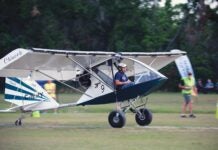 KITPLANES magazine met with Mark Giron of FAA headquarters on the opening day of Sun ‘n Fun to discuss progress on the concept of giving builders the option of having two pilots on board during Phase One testing of new Experimental aircraft. The proposal is in response to NTSB recommendations attempting to lower the accident rate in Experimental aircraft, and points at the problem of inexperienced pilot builders doing their own testing while solo because current Operating Limitations for Experimental aircraft only allow required crew members to be onboard during initial flight testing—and most light Experimental aircraft can be flown by a single pilot.
KITPLANES magazine met with Mark Giron of FAA headquarters on the opening day of Sun ‘n Fun to discuss progress on the concept of giving builders the option of having two pilots on board during Phase One testing of new Experimental aircraft. The proposal is in response to NTSB recommendations attempting to lower the accident rate in Experimental aircraft, and points at the problem of inexperienced pilot builders doing their own testing while solo because current Operating Limitations for Experimental aircraft only allow required crew members to be onboard during initial flight testing—and most light Experimental aircraft can be flown by a single pilot.
Unfortunately, statistics show that most accidents in Phase One occur in the first eight hours of an aircraft’s life, and a significant portion of those are due to loss of control, with the second major cause being powerplant failures. Inexperienced pilots that get behind the airplane or don’t handle engine or fuel system problems properly can come to grief very quickly. Because many builders insist on being in the airplane they built on its maiden flights, they are caught between the rules and a hard place—and many wish they could have an experienced pilot onboard. Although the least risky option is to let an experienced pilot fly the airplane solo on its first flights, many reject this option, and get into situations beyond their skill level.
The new proposal allows very experienced pilots who meet a certain set of experience requirements to act as a “Qualified Pilot” to assist these pilots with their first flight. The program, which will be defined via an Advisory Circular, will be voluntary—builders can still take their airplane up solo with any level of experience. But should they choose to take along an experienced pilot, the AC will define the standards required for the Qualified Pilot so that two people will be able to occupy the aircraft legally. This will require modifications to existing Operating Limitations for aircraft that already have an Experimental Airworthiness Certificate; once the program is in place, this permission will be standard in all Operating Limitations.
Giron told KITPLANES that the proposed AC is still in review at the FAA, and he hopes that it will be available soon. He acknowledges that many Qualified Pilots might balk at the idea of taking an additional person along on a first flight, and that there is nothing compelling them to do so if they feel that the risk is unacceptable. At the same time, many experienced pilots, when faced with the fact that the inexperienced pilot will decide take their airplane aloft solo if they don’t agree to go along, might agree in order to keep the new builder safe.
KITPLANES will report further on this new policy as it develops.













